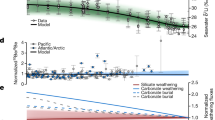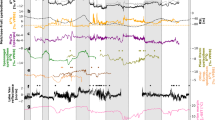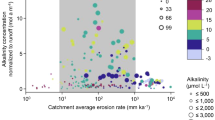Abstract
The Earth underwent several snowball glaciations between 1,000 and 542 million years ago. The termination of these glaciations is thought to have been triggered by the accumulation of volcanic CO2 in the atmosphere over millions of years1,2. Subsequent high temperatures and loss of continental ice would increase silicate weathering and in turn draw down atmospheric CO2 (ref. 3). Estimates of the post-snowball weathering rate indicate that equilibrium between CO2 input and removal would be restored within several million years 4, potentially triggering a new glaciation. However the transition between deglaciation and the onset a new glaciation was on the order of 107 years. Over long timescales, the availability of fresh rock can become a limiting factor for silicate weathering rates5. Here we show that when this transport-determined limitation is incorporated into the COPSE biogeochemical model6, the stabilization time is substantially longer, >107 years. When we include a simple ice-albedo feedback, the model produces greenhouse–icehouse oscillations on this timescale that are compatible with observations. Our simulations also indicate positive carbon isotope excursions and an increased flux of oxygen to the atmosphere during interglacials, both of which are consistent with the geological record7,8. We conclude that the long gaps between snowball glaciations can be explained by limitations on silicate weathering rates.
This is a preview of subscription content, access via your institution
Access options
Subscribe to this journal
Receive 12 print issues and online access
$259.00 per year
only $21.58 per issue
Buy this article
- Purchase on Springer Link
- Instant access to full article PDF
Prices may be subject to local taxes which are calculated during checkout




Similar content being viewed by others
References
Hoffman, P. F., Kaufman, A. J., Halverson, G. P. & Schrag, D. P. A Neoproterozoic Snowball Earth. Science 281, 1342–1346 (1998).
Pierrehumbert, R. T. Climate dynamics of a hard snowball Earth. J. Geophys. Res. 110, D01111 (2005).
Walker, J. C. G., Hays, P. B. & Kasting, J. F. A negative feedback mechanism for the long-term stabilization of Earth’s surface temperature. J. Geophys. Res. 86, 9776–9782 (1981).
Le Hir, G. et al. The snowball Earth aftermath: Exploring the limits of continental weathering processes. Earth Planet. Sci. Lett. 277, 453–463 (2009).
West, A. J., Galy, A. & Bickle, M. Tectonic and climatic controls on silicate weathering. Earth Planet. Sci. Lett. 235, 211–228 (2005).
Bergman, N. M., Lenton, T. M. & Watson, A. J. COPSE: A new model of biogeochemical cycling over Phanerozoic time. Am. J. Sci. 304, 397–437 (2004).
Halverson, G. P., Hoffman, P. F., Schrag, D. P., Maloof, A. C. & Rice, H. N. Toward a Neoproterozoic composite carbon-isotope record. Geol. Soc. Am. Bull. 117, 1181–1207 (2005).
Canfield, D. E. et al. Ferruginous conditions dominated later Neoproterozoic deep-water chemistry. Science 321, 949–952 (2008).
Hoffmann, K-H., Condon, D. J., Bowring, S. A. & Crowley, J. L. U–Pb zircon date from the Neoproterozoic Ghaub Formation, Namibia: Constraints on Marinoan glaciation. Geology 32, 817–820 (2004).
Kirschivink, J. L. in The Proterozoic Biosphere: A Multidisciplinary Study (eds Schopf, J. W. & Klein, C.) 51–52 (Cambridge Univ. Press, 1992).
Millot, R., Gaillardet, J., Dupre, B. & Allegre, C. J. The global control of silicate weathering rates and the coupling with physical erosion: New insights from rivers of the Canadian Shield. Earth Planet. Sci. Lett. 196, 83–98 (2002).
Wilkinson, B. H. & McElroy, B. J. The impact of humans on continental erosion and sedimentation. Geol. Soc. Am. Bull. 119, 140–156 (2007).
Gaillardet, J., Dupre, B., Louvat, P. & Allegre, C. J. Global silicate weathering and CO2 consumption rates deduced from the chemistry of large rivers. Chem. Geol. 159, 3–30 (1999).
Rino, S. et al. Major episodic increases of continental crustal growth determined from zircon ages of river sands; implications for mantle overturns in the Early Precambrian. Phys. Earth Planet. Inter. 146, 369–394 (2004).
Willenbring, J. K. & Blanckenburg, F. V. Long-term stability of global erosion rates and weathering during late-Cenozoic cooling. Nature 465, 211–214 (2010).
Franck, S. & Bounama, C. Continental growth and volatile exchange during Earth’s evolution. Phys. Earth Planet. Inter. 100, 189–196 (1997).
Hayes, J. M. & Waldbauer, J. R. The carbon cycle and associated redox processes through time. Phil. Trans. R. Soc. B 361, 931–950 (2006).
Berner, R. A. GEOCARB II: A revised model of atmospheric CO2 over Phanerozoic time. Am. J. Sci. 294, 56–91 (1994).
Vance, D., Teagle, D. A. H. & Foster, G. L. Variable Quaternary chemical weathering fluxes and imbalances in marine geochemical budgets. Nature 458, 493–496 (2009).
Donnadieu, Y., Fluteau, F., Ramstein, G., Ritz, C. & Besse, J. Is there a conflict between the Neoproterozoic glacial deposits and the snowball Earth interpretation: An improved understanding with numerical modeling. Earth Planet. Sci. Lett. 208, 101–112 (2003).
Donnadieu, Y., Godderis, Y., Ramstein, G., Nedelec, A. & Meert, J. A ‘snowball Earth’ climate triggered by continental break-up through changes in runoff. Nature 428, 303–306 (2004).
Li, Z. X. et al. Assembly, configuration, and break-up history of Rodinia: A synthesis. Precambr. Res. 160, 179–210 (2008).
Hoffman, P. F. & Schrag, D. P. The snowball Earth hypothesis: Testing the limits of global change. Terra Nova 14, 129–155 (2002).
Caldeira, K. & Kasting, J. F. The life span of the biosphere revisited. Nature 360, 721–723 (1992).
Lewis, E. & Wallace, D. W. R. Program Developed for CO 2 System Calculations. Report no. ORNL/CDIAC 105 (Oak Ridge National Laboratory, 1998).
Shields, G. A. et al. Neoproterozoic glaciomarine and cap dolostone facies of the southwestern Taoudeni Basin (Walidiala Valley, Senegal/Guinea, NW Africa). C. R. Geosci. 339, 186–199 (2007).
Porter, S. M., Knoll, A. H. & Affaton, P. Chemostratigraphy of Neoproterozoic cap carbonates from the Volta Basin, West Africa. Precambr. Res. 130, 99–112 (2004).
Zhu, M., Zhang, J. & Yang, A. Integrated Ediacaran (Sinian) chronostratigraphy of South China. Palaeogeogr. Palaeoclimatol. Palaeoecol. 254, 7–61 (2007).
Scott, C. et al. Tracing the stepwise oxygenation of the Proterozoic ocean. Nature 452, 456–459 (2008).
Kasemann, S. A., Hawkesworth, C. J., Prave, A. R., Fallick, A. E. & Pearson, P. N. Boron and calcium isotope composition in Neoproterozoic carbonate rocks from Namibia: Evidence for extreme environmental change. Earth Planet. Sci. Lett. 231, 73–86 (2005).
Acknowledgements
B.M. is funded by a UEA Dean’s studentship. A.J.W.’s contribution was supported by a Royal Society Research Professorship. Part of C.G.’s contribution was supported by a NASA Postdoctoral Fellowship at Ames Research Center and by the NASA Astrobiology Institute Virtual Planetary Laboratory lead team. A.J.W., R.B. and T.M.L. are supported by the NERC project (NE/I005978/1) ‘Reinventing the planet: The Neoproterozoic revolution in oxygenation, biogeochemistry and biological complexity’.
Author information
Authors and Affiliations
Contributions
B.M. and A.J.W. suggested the mechanism, following previous work by R.B. and T.M.L. B.M. wrote the model. Results were analysed by B.M. and A.J.W. Discussion with C.G. helped improve the method. R.B. and T.M.L. contributed to the manuscript.
Corresponding author
Ethics declarations
Competing interests
The authors declare no competing financial interests.
Supplementary information
Supplementary Information
Supplementary Information (PDF 503 kb)
Rights and permissions
About this article
Cite this article
Mills, B., Watson, A., Goldblatt, C. et al. Timing of Neoproterozoic glaciations linked to transport-limited global weathering. Nature Geosci 4, 861–864 (2011). https://doi.org/10.1038/ngeo1305
Received:
Accepted:
Published:
Issue Date:
DOI: https://doi.org/10.1038/ngeo1305
This article is cited by
-
A 200-million-year delay in permanent atmospheric oxygenation
Nature (2021)
-
Correlative Microscopy: a tool for understanding soil weathering in modern analogues of early terrestrial biospheres
Scientific Reports (2021)
-
A Review of the Neoproterozoic Global Glaciations and a Biotic Cause of Them
Earth Systems and Environment (2021)
-
Warm afterglow from the Toarcian Oceanic Anoxic Event drives the success of deep-adapted brachiopods
Scientific Reports (2020)
-
Middle Eocene greenhouse warming facilitated by diminished weathering feedback
Nature Communications (2018)



